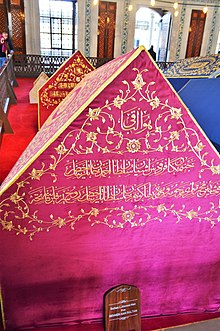Gevherhan Sultan (daughter of Ahmed I)
| Gevherhan Sultan | |
|---|---|
 Tomb of Gevherhan Sultan, Sultanahmet Square, Istanbul | |
| Born | c. 1605 or 1608 Topkapi Palace, Constantinople, Ottoman Empire (present day Istanbul, Turkey) |
| Died | 1660 (age 51–55) Constantinople, Ottoman Empire (present day Istanbul, Turkey) |
| Burial | Sultan Ahmed Mosque, Istanbul |
| Spouse | |
| Issue | First marriage Sultanzade Fülan Bey Second marriage Safiye Hanımsultan |
| Dynasty | Ottoman |
| Father | Ahmed I |
| Mother | Kösem Sultan |
| Religion | Sunni Islam |
Gevherhan Sultan (Ottoman Turkish: کوھرخان سلطان, "Gem of the Khan"; c. 1605 or 1608[1]–1660) was an Ottoman princess, daughter of Sultan Ahmed I (reign 1603–1617) and Kösem Sultan,[2][3] half-sister of Sultan Osman II (reign 1618–1622), and sister of Sultans Murad IV (1623–1640) and Ibrahim (reign 1640–1648) of the Ottoman Empire.
Birth[edit]
Gevherhan was born in Constantinople between 1605 and 1608.[1][2] His father, Sultan Ahmed I named her in honor of his great aunt Gevherhan Sultan, who had introduced his mother Handan Sultan to his father Mehmed III.[4]
Her mother was Kösem Sultan, Haseki of Ahmed.[2][3]
First marriage[edit]
In the summer of 1612, Gevherhan was married, as arranged by Ahmed, to Öküz Kara Mehmed Pasha, who served as the governor of Egypt from 1607 to 1611, and Grand Admiral of the Ottoman fleet in 1611.[5] The wedding took place at the Old Palace, and the couple were given the Palace of Ibrahim Pasha as their residence.[6] Over a seven-month period, the expenses for providing bread, rice, and lamb to wedding guests and the capital's residents amounted to nearly 2,000,000 aspers. Additionally, during the festivities, an unidentified French observer in Istanbul witnessed Gevherhan's opulent dowry, featuring a solid gold bride-crown, a large chest filled with precious stones and jewels, and numerous rolls of silk.[7] Mehmed served as Grand Vizier from 1614 until 1616 under Ahmed, and then again for a few months in 1619 under Osman II.[8] After being dismissed from the office a second time, he died in Aleppo in around 1621. With him, Gevherhan had a son who name is unknown and who died in infancy, born in 1621/1622.[9]
Second marriage[edit]
In 1622,[10][11] during Osman II's reign, Gevherhan married Topal Recep Pasha,[12][10] who in 1632 served as Grand Vizier under her brother Murad IV and was executed in same year. With Recep Pasha, she had a daughter named Safiye Hanımsultan (January 1630 – 1682), [13][14] who in turn married the future Grand Vizier Abaza Siyavuş Pasha.[15]
In popular culture[edit]
- In the 2015 TV series Muhteşem Yüzyıl: Kösem, Gevherhan is portrayed by Turkish actresses Çağla Naz Kargı and Asli Tandoğan as a child and adult respectively.[16]
See also[edit]
- Ottoman dynasty
- Ottoman family tree
- Ottoman Emperors family tree (simplified)
- List of Ottoman Princesses
References[edit]
- ^ a b Gevherhan and her sister Ayşe Sultan were born one in 1605 and one in 1608, but historians are uncertain about assigning dates
- ^ a b c Singh, Nagendra Kr (2000). International encyclopaedia of Islamic dynasties (reproduction of the article by M. Cavid Baysun "Kösem Walide or Kösem Sultan" in The Encyclopaedia of Islam vol V). Anmol Publications PVT. pp. 423–424. ISBN 81-261-0403-1.
Through her beauty and intelligence, Kösem Walide was especially attractive to Ahmed I, and drew ahead of more senior wives in the palace. She bore the sultan four sons – Murad, Süleyman, Ibrahim and Kasim – and three daughters – 'Ayşe, Fatma and Djawharkhan. These daughters she subsequently used to consolidate her political influence by strategic marriages to different viziers.
- ^ a b Peirce 1993, p. 365.
- ^ Borekçi 2010, p. 94.
- ^ Tezcan 2001, p. 337 n. 81.
- ^ Dumas 2013, p. 552-9.
- ^ Borekçi 2010, pp. 240–241.
- ^ Watenpaugh, Heghnar Zeitlian (2004). The Image Of An Ottoman City: Imperial Architecture And Urban Experience In Aleppo In The 16th And 17th Centuries. BRILL. p. 142. ISBN 978-9-004-12454-7.
- ^ Ayvansaray-i, Hafiz Hueseyin (2000). The Garden of the Mosques: Hafiz Hüseyin Al-Ayvansarayî's Guide to the Muslim Monuments of Ottoman Istanbul. Brill. p. 30. ISBN 978-9-004-11242-1.
- ^ a b Dumas 2013, p. 564.
- ^ Efendi, A.; Yılmazer, Z. (2003). Topçular Katibi ʻAbdülkādir (Kadrı) Efendi Tarihi: metin ve tahlıl. Publications de la Société d'histoire turque. Türk Tarih Kurumu Basımevi. p. 757. ISBN 978-975-16-1585-5.
- ^ Tezcan 2001, p. 334 n. 58.
- ^ Dumas 2013, p. 462.
- ^ Mustafa Naima Efendi (1968). Naîmâ Târihi - Cilt 3. Zuhuri Danişman Yayinevi. p. 1097.
- ^ Dumas 2013, p. 570.
- ^ "Gevherhan Sultan - Aslı Tandoğan". www.fox.com.tr. Retrieved 2017-10-21.
Sources[edit]
- Borekçi, Günhan (2010). Factions And Favorites At The Courts Of Sultan Ahmed I (r. 1603-17) And His Immediate Predecessors.
- Dumas, Juliette (2013). Les perles de nacre du sultanat: Les princesses ottomanes (mi-XVe – mi-XVIIIe siècle).
- Peirce, Leslie P. (1993). The Imperial Harem: Women and Sovereignty in the Ottoman Empire. Oxford University Press. ISBN 978-0-195-08677-5.
- Tezcan, Baki (November 2001). Searching for Osman: A reassessment of the deposition of the Ottoman Sultan Osman II (1618-1622) (PhD Thesis). Princeton University.

